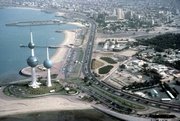Kuwait City
|
|
Kuwait City's trade and transportation needs are served by Kuwait International Airport, Mina Al-Shuwaik (Shuwaik Port) and 50 kilometers to the south by the port of Mina al-Ahmadi (Ahmadi Port) on the Persian Gulf coast.
The city was invaded and seized by Iraqi forces in the 1991 Gulf War. Under Iraqi occupation it was renamed Saddam City in honor of Iraqi leader Saddam Hussein. It returned to its original name once Iraqi troops were expelled.
Kuwait_city_1996.jpg
During the invasion, the city was extensively bombed and damaged. Buildings were fired upon, set alight, and demolished; roads and bridge links were the targets of explosives, and landmarks were defaced. The Kuwait National Museum, for example, which once held an extensive, comprehensive, and beautiful collection of artwork, was looted and then torched. The Kuwait Towers, the symbols of the country, were the targets of Saddam Hussein, who aimed to demolish them. Fortunately, only minor damage was done to the Towers, and they are still the nation's symbol.
After the invasion's terrible onslaught, foreign investors and the Kuwaiti government are actively involved in modernizing the city and transforming it into a world-class, state-of-the-art business hub. Today, virtually all traces of the invasion have been cleared, and construction cranes dot the skyline as skyscrapers lift off from the ground and reach upwards. Many new hotels, including an exclusive Four Seasons and InterContinental, are now under construction, signaling a new era of growth for Kuwait City. The city is already in excellent shape, with new buildings with modern designs taking shape and glittering shopping malls opening. Some tourists are already present in the city, most of them looking for a relaxing beach getaway.de:Kuwait (Stadt) eo:Kuvajto (urbo) io:Kuwait-Urbo nl:Koeweit (stad) pl:Kuwejt (miasto) pt:Kuwait (cidade) sk:Kuvajt (mesto) fi:Kuwait (kaupunki) sv:Kuwait City

